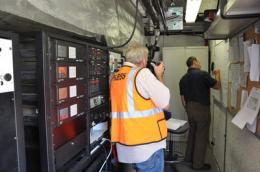Small stone blades and a reddish body pigment recently discovered in a cave near the southern tip of South Africa suggest that the use of symbolism and tools -- hallmarks of modern human behavior -- had already begun to develop 164,000 years ago, far earlier than previously believed, researchers report.
Arizona researchers also found in the cave the earliest evidence of seafood consumption. The earliest previous evidence of the consumption of shellfish was dated to 125,000 years ago, and the oldest stone tools, known as bladelets, were 70,000 years old.
Researchers know that modern humans evolved in Africa between 100,000 and 200,000 years ago, but there has been little archeological evidence available to pin down a timeline.
Evidence along the coastlines has been particularly scarce because rising ocean waters after the end of the last glacial period obliterated most sites.
The new evidence comes from a cave at Pinnacle Point on Mossel Bay, about halfway between Cape Town and Port Elizabeth. The cave would have been two to three miles inland at the time it was occupied, high enough above sea level to be safe from flooding.
A team headed by anthropologist Curtis Marean of Arizona State University's Institute of Human Origins reported Thursday in the journal Nature that it found shells from cooked seafood in the cave, including brown and black mussels, small saltwater clams, sea snails and even a barnacle, which is typically found on whale blubber or skin.
Seafood was the last item added to the diet of humans before they began to domesticate animals and grow their own food. Marean said the ancient humans brought the shellfish to the cave and cooked it over hot rocks, which caused it to pop open. When Marean's team replicated the process, they found the food tasty but a little dry, he said.
The small bladelets, about the size of a pinky finger, are thought to have been attached to spears, often in multiples, providing an advantage over hand-held tools.
The red ocher pigment, found in the form of 57 lumps of hematite collected by the cave dwellers, would have been used for decorating their bodies and coloring artifacts. Such decoration is thought to be an early manifestation of symbolism. The decoration was used to convey messages to other peoples living in the vicinity.
Africa was cold and very dry during this period, and Marean and his colleagues speculated that the shellfish were a kind of "starvation food" the early humans turned to when there was little else available.
Evidence indicates there were only a handful of places in Africa where humans could have survived during this glacial period. Mossel Bay may have been one of them, they said.
"It is possible that this population could be the progenitor population for all modern humans," they wrote.
--------------------------------------------------------------------------------
Key Human Traits Tied to Shellfish Remains
--------------------------------------------------------------------------------
Almost from the start, it seems, humans headed for the shore. But this was no holiday for them. More than likely, it was a matter of survival at a perilous time of climate change in Africa 164,000 years ago.
By then Homo sapiens had developed a taste for shellfish - much earlier than previously thought, scientists report in today's issue of the journal Nature - as the species was adapting to life in caves on the craggy coast of southern Africa.
Exploring a cave in a steep cliff overlooking the ocean, an international team of scientists found deposits of shellfish remains, hearths, small stone blades and fragments of hematite, some of which, the scientists believe, had been ground for use as the coloring agent red ochre that sometimes had symbolic meaning.
"The shellfish," the researchers concluded, "may have been crucial to the survival of these early humans as they expanded their home ranges" in response to the cooler and drier conditions that had prevailed for thousands of years in the interior of Africa.
Curtis W. Marean, the team leader and a paleoanthropologist with the Institute of Human Origins at Arizona State University, said, "Shellfish was one of the last additions to the human diet before domesticated plants and animals were introduced," more than 10,000 years ago.
In an accompanying article, Sally McBrearty of the University of Connecticut and Chris Stringer of the Natural History Museum in London, who were not involved in the research, said the find provided "strong evidence that early humans displayed key elements of modern behavior" as early as 164,000 years ago.
The discovery was made in a cave at Pinnacle Point near Mossel Bay on the southern coast of South Africa, about 200 miles east of Cape Town.
Previous research had indicated that human ancestors had for ages depended solely on terrestrial plants and animals. Both fossil and genetic data show that modern humans evolved 150,000 to 200,000 years ago, but archaeological evidence for the emergence of modern behavior in technology, creativity, symbolic thinking and lifestyles is sparse.
But six years ago, at Blombos Cave, near Pinnacle Point, archaeologists uncovered 77,000-year-old tools along with pigments and engraved stones suggesting symbolic behavior, a sign of early creativity. Now, at the Pinnacle Point cave site, the shellfish remains reveal another important innovation.
Other coastal populations had been found exploiting marine resources as early as 125,000 years ago. Neanderthals were cooking shellfish in Italy about 110,000 years ago.
The presence of red ochre at Pinnacle Point, Dr. Marean's team also reported, indicated that at this time humans already "inhabited a cognitive world enriched by symbols." The researchers said the material had both symbolic and utilitarian functions and was probably used for body painting and for coloring artifacts.
Until recently, anthropologists generally assumed that modern human behavior arose much more recently, probably around 45,000 years ago, as a consequence of some unidentified change in brain function that favored communication and symbolic thinking to express social status and group identity. This interpretation was based on the apparently sudden appearance of art and self-adornment at sites in Europe.
The search for early human use of marine resources, supported by the National Science Foundation, centered on the cave at Pinnacle Point because of its position high on a cliff. Other seashore sites of early human occupation had been inundated by the rise in sea level, beginning about 115,000 years ago at the end of Africa's long arid conditions.
Forced to seek new sources of food, some of the people migrated to the shore in search of "famine food." At Pinnacle Point, the discovery team reported, they feasted on a variety of marine life, brown mussels, giant periwinkles and whelks.
So on the southern shore of Africa, Dr. Marean said in a statement issued by Arizona State, a small population of cave-dwelling modern humans struggled and survived through the prevailing cold, eating shellfish and developing somewhat advanced technologies.
"It is possible," he concluded, "that this population could be the progenitor population for all modern humans."

 Google undeservedly receives credit for many clicks on the online ads it delivers via its search engine, but Microsoft wants to put a stop to that.Google Inc. has gotten undeservedly all the credit for many clicks on the online ads it delivers via its search engine, but Microsoft Corp. wants to put a stop to that.
Google undeservedly receives credit for many clicks on the online ads it delivers via its search engine, but Microsoft wants to put a stop to that.Google Inc. has gotten undeservedly all the credit for many clicks on the online ads it delivers via its search engine, but Microsoft Corp. wants to put a stop to that.

 Air Force weapons officers assigned to secure nuclear warheads failed on five occasions to examine a bundle of cruise missiles headed to a B-52 bomber in North Dakota, leading the plane's crew to unknowingly fly six nuclear-armed missiles across the country.
Air Force weapons officers assigned to secure nuclear warheads failed on five occasions to examine a bundle of cruise missiles headed to a B-52 bomber in North Dakota, leading the plane's crew to unknowingly fly six nuclear-armed missiles across the country.


 "The first thing we did was a post-delivery inspection and checkout to make sure the ferry flight from Italy to Florida didn't cause any damage to the module," said Glenn Chin, the payload mission manager for STS-120. Since then, a team of technicians has worked to prepare it for flight.
"The first thing we did was a post-delivery inspection and checkout to make sure the ferry flight from Italy to Florida didn't cause any damage to the module," said Glenn Chin, the payload mission manager for STS-120. Since then, a team of technicians has worked to prepare it for flight.



 People are more likely to believe findings from a neuroscience study when the report is paired with a colored image of a brain as opposed to other representational images of data such as bar graphs, according to a new Colorado State University study. (Credit: iStockphoto/Aaron Kondziela)
People are more likely to believe findings from a neuroscience study when the report is paired with a colored image of a brain as opposed to other representational images of data such as bar graphs, according to a new Colorado State University study. (Credit: iStockphoto/Aaron Kondziela)
 Hughes Medical Institute investigator, and colleagues appearing in the Oct. 23 issue of Current Biology shows that the same protein that enables a yeast cell to bud into two daughter cells also helps neurons sprout the branch-like protrusions used to communicate with other neurons.
Hughes Medical Institute investigator, and colleagues appearing in the Oct. 23 issue of Current Biology shows that the same protein that enables a yeast cell to bud into two daughter cells also helps neurons sprout the branch-like protrusions used to communicate with other neurons. Pollution , and purification is always a burning question , awaring the CEC's goal ,The latest Taking Stock report from the Commission for Environmental Cooperation (CEC) reveals that a continued decline in releases of toxic chemicals to the environment--15 percent for the United States and Canada from 1998 to 2004--is being driven by a group of industrial facilities that are the largest generators of emissions
Pollution , and purification is always a burning question , awaring the CEC's goal ,The latest Taking Stock report from the Commission for Environmental Cooperation (CEC) reveals that a continued decline in releases of toxic chemicals to the environment--15 percent for the United States and Canada from 1998 to 2004--is being driven by a group of industrial facilities that are the largest generators of emissions
 James Watson, who won the Nobel Prize for co-discovering the molecular structure of DNA, has been sharply criticized in Britain for reportedly saying tests showed Africans did not have the same level of intelligence as whites.
James Watson, who won the Nobel Prize for co-discovering the molecular structure of DNA, has been sharply criticized in Britain for reportedly saying tests showed Africans did not have the same level of intelligence as whites. Ber
Ber